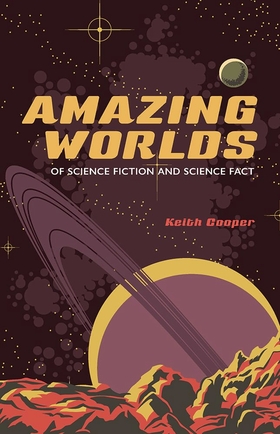Centauri Dreams
Imagining and Planning Interstellar Exploration
How Americans See Space Exploration
These are unusual times for a site that usually begins its investigations no closer than the outer Solar System (asteroids are an exception). But there is no way to ignore the Apollo 11 anniversary, nor would I even consider it. Tomorrow I’ll have further reminiscences from Al Jackson, who was on the scene in Houston when Apollo touched the Moon, and on Friday a piece from Neil McAleer with substantial portions of a speech Neil Armstrong gave in Australia in 2011.
For today, a look at how the public views space exploration in our era and earlier, with the surprising result that there seems to be more interest in space than I had assumed. In fact, while it has often seemed as if interest peaked with the moon landings and then slackened, turning instead to space programs of the imagination via high-budget films, there is new evidence that the work we track on Centauri Dreams has a good deal of support.
According to a recent survey, over 70 percent of Americans liken the exploration of space to the European voyages that opened up the western hemisphere and established outposts and trade routes throughout Asia and the Pacific. That’s a higher number than I would have expected, one that reflects, in the words of Jon Miller, director of the International Center for the Advancement of Scientific Literacy at the University of Michigan’s Institute for Social Research, “…the deep-seated impact of the first moon landing in American culture.”
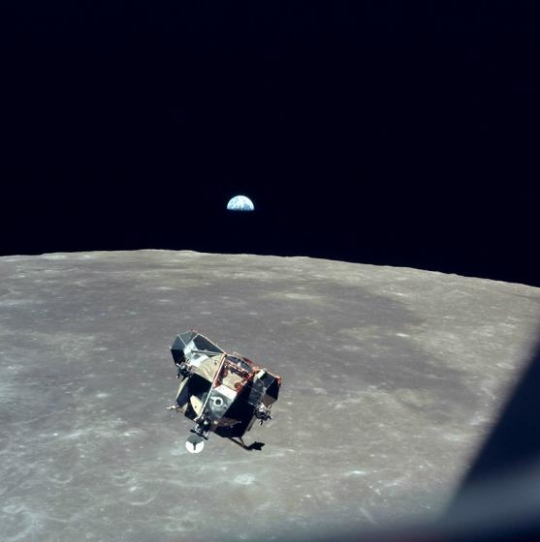
Image: Taken by Michael Collins, this photo shows the lunar excursion module, the Moon, and the Earth from Columbia, the command module, as Armstrong and Aldrin return from the lunar surface. Credit: NASA.
So is this a simple nod to a cherished memory? After all, those who were alive in those days will never forget the experience, a global one, of leading their daily lives with one eye always on the three astronauts on their way to the Moon. Maybe there’s more to it than that, given that the percentage of adult Americans who were alive on July 20, 1969, is only 45%. There does seem to be some movement in peoples’ perception of space exploration, one that this survey tracks.
We’re dealing with the Michigan Scientific Literacy Study, compiled in 2018, with data collected by AmeriSpeak, which is a service of the National Opinion Research Center at the University of Chicago. The survey was taken in November and December of last year and included both online and telephone interviews with 2,312 adults age 18 and older. I have no expertise whatsoever in such surveys, and so cannot judge this one’s accuracy. But let me quote it:
A national survey conducted in 1988 found that 67% of American adults agreed that we should think of space exploration in terms similar to the early explorers of this planet. Thirty years later, a 2018 national survey found that 72% of American adults agreed with the same statement. This level of continuing general support for space exploration indicates that most Americans see the last six decades as a period of positive achievement and that they are supportive of continued efforts to explore space.
Again, I’m surprised. Maybe I’ve been too pessimistic. The study from thirty years earlier refers to the work of the Public Opinion Laboratory at Northern Illinois University, which sampled 2,041 adults by telephone on the same topics. This one was published in the National Science Board’s Science and Engineering Indicators for 1988. The current survey repeated a question from 1988’s survey, asking for agreement or disagreement on this statement: “The space program has paid for itself through the creation of new technologies and scientific discoveries.”
Here again the numbers were something of a surprise, at least to me. Thirty years ago, 56 percent of adults agreed with the statement. In 2018, that percentage had risen to 69%. That’s a fairly robust figure, and it removes the perceived benefits of the space program from the experience of having watched the Apollo missions themselves. Says Miller: “This pattern reflects a long-standing public belief in the indirect benefit of the space program apart from spectacular events like the lunar landing.”
The question I mentioned in the first paragraph on the exploratory impulse asked respondents to agree or disagree with the statement “The United States should seek to explore space in the same spirit that led Europeans to explore this planet in earlier centuries.” 1988’s figure was 69 percent, roughly the same as the 72% tagged in the 2018 results. Interestingly, older adults were more supportive of this view in 2018 than they were in the earlier survey, while men were more supportive than women, though with a difference that has narrowed over the years.
You can see the results of the 2018 survey here. Another excerpt:
This brief examination of national survey data from 1988 and 2018 indicates that American adults tend to recall the first Apollo lunar landing as a landmark achievement of the space program, citing it more often than any other activity as the best achievement of the space program. Parallel national survey data indicate that a majority of American adults think that the space program has paid for itself through the development of new technologies and new scientific discoveries. The proportion of American adults holding this belief has increased steadily over the last 30 years.
Here’s the survey’s Table 2, labeled “Public agreement with statement concerning the value of new technologies from the space program, 1988-2018.”
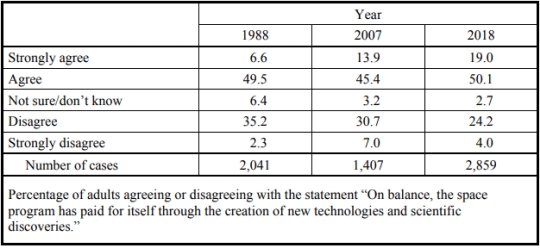
What to make of all this? It’s heartening to see the rise, a steady one, in the proportion of adults who believe the space program has been worthwhile in producing new technologies and generating scientific data. This recognition of the program’s value and the substantial majority of Americans who see space exploration as similar to earlier periods of exploration shows that there is public support for future missions. At the same time, note this: One in five adult Americans were unable to recall any achievements of the space program.
Let’s go with the other 4/5ths. It’s no surprise that, for them, the landing of Apollo 11 on the Moon ranks as the most important result of the space program in its first 60 years, and the media attention to Apollo accompanying the anniversary reinforces that perception. But even as more than 70 percent of Americans want to see space exploration continue, there is no information within this work that shows us how to translate this interest into larger budgets for space.
Remember that Apollo at one point was absorbing 4.4 percent of the federal budget. According to a recent analysis by The Planetary Society (reported in this CBS news analysis), that is the equivalent of spending NASA’s current annual budget on a single project and sustaining the effort for over a decade, some $288.1 billion in inflation-adjusted dollars. This at a time, at least in the earlier ’60s, when rather than today’s gigantic deficits, the United States had a budgetary surplus and increased spending as a way to stimulate the economy was much in the air.
So while a new Gallup poll backs the University of Michigan study that most Americans support space exploration, the kind of big-ticket effort that Apollo represented is ruled out by financial realities. Even so, exciting exoplanet discoveries and spectacular one-off missions like New Horizons are holding the public’s interest, and there is a sense that space delivers tangible results in everyday life as well as scientific return. As we celebrate Apollo 11, then, we can remember how unique the entire Apollo effort was while recognizing that there is still support for creative missions that expand the human spirit while operating on a much slimmer budget.
It would be fascinating to see similar polling on space in Europe and Asia. If anyone has any leads on such, please let me know.

On Apollo, Hayabusa2 & Persistence

Remembering how I felt 50 years ago when Apollo 11 launched, I fully understand those whose sense of let-down at the abrupt end of the moon landings has never gone away. And yes, I was one of those who assumed we would be on Mars by 1990 or earlier, with missions to the Jovian moons gearing up about now. Events in the interim have proven these expectations unrealistic, but last night as I was reminiscing I also thought about what we had done in those 50 years.
50 years ago, for example, the idea of Europa as an ocean world was still a few years out, only entering into serious speculation after Voyager 1 showed us what Jupiter’s immense tidal forces, aided by the gravitational effects of Europa and Ganymede, could do to Io. That flyby was in March of 1979, and if Io’s volcanoes told a tale, they also implicated Europa’s abundant ice. The Galileo mission, despite its problems, then showed us a Europan surface wracked by movement, with ‘chaos’ features, raft-like ice blocks evidently once afloat, frozen into a geologically young terrain. Europa was becoming very interesting indeed.
In 1969 we knew none of this, nor did we have much of an idea what was beneath Titan’s clouds, not to mention what was being flung into space out of bright, frozen Enceladus’ south pole. We hadn’t seen Pluto and its big moon Charon, or viewed a Kuiper Belt Object up close. We were a few years away from Viking (and those landings are another special memory), Mars rovers were only a hope for the future, and no comet had ever been explored.
Exoplanets? Forget it. Who dreamed we had the ability to find them?
The list could go on, but there is no need to recount every robotic mission discovery. While astronauts remained in low Earth orbit, we did indeed perform the initial reconnaissance of the Solar System, and if a mission like Cassini or Kepler doesn’t hold you spellbound, nothing will. You can see that I’m trying to cheer myself up as I look at those unfulfilled expectations of July 16, 1969, but I do think it’s sensible to take stock and appreciate what robotic instrumentation can do amidst the revolution in digital technologies that have transformed our world.
Operations on an Asteroid
So we keep doing what we can with the resources that have been allocated, knowing how much more could be done. Today we look at an asteroid. What follows is imagery from Japan’s Hayabusa 2 mission, which touched down just a few days ago on the asteroid Ryugu, a second landing after the one performed in February. Here we’re seeing views from the spacecraft’s small monitor camera (CAM-H), which operated throughout touchdown, with a field of view looking downwards toward the sampler horn. I’ll just run these in sequence.
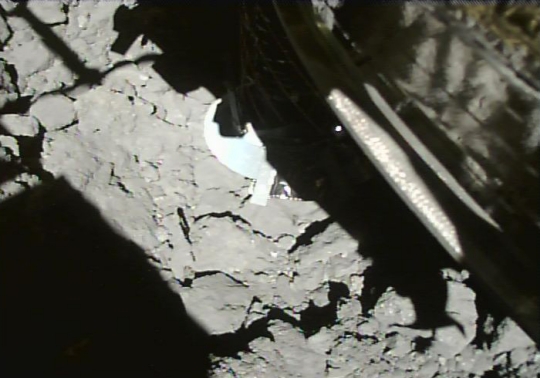
Image: Taken 4 seconds before touchdown with CAM-H (Credit: JAXA).
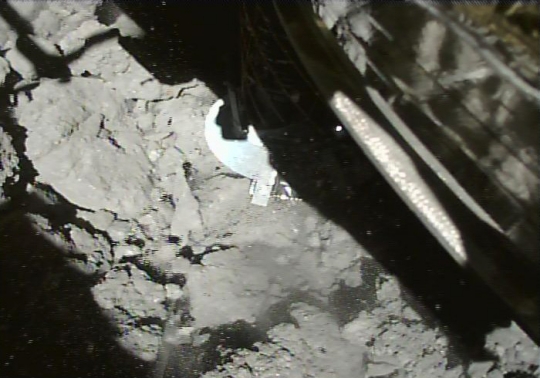
Image: The moment of touchdown captured with CAM-H?Credit?JAXA).
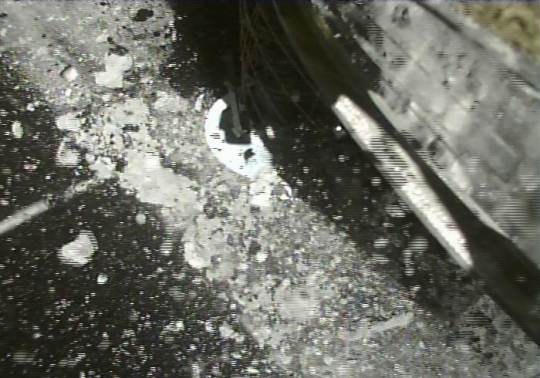
Image: Taken 4 seconds after touchdown with CAM-H (Credit: JAXA).
Nice work indeed, and congratulations to the team that pulled it off. Following events on Twitter at https://twitter.com/haya2e_jaxa was a great way to track the landing minute by minute. The point here is to do a sample return, and you’ll recall that previous Hayabusa2 operations have included the use of a projectile to create a crater whose exposed material could then be sampled before the craft once again ascended. Time on the surface was brief, with Hayabusa2 swiftly returning to a safe position near the asteroid. The departure for Earth is now contemplated for some time late in the year. Have a look at this mission calendar to get a sense of how much has been done, and to keep up with changes to the schedule going forward.
[PPTD] Thank you for your support from all over the world! Everyone in the control room is making a cheerful V-sign for the second touchdown! pic.twitter.com/YUz7sVmQPb
— HAYABUSA2@JAXA (@haya2e_jaxa) July 11, 2019
We also have OSIRIS-REx at asteroid Bennu, another carbon-rich asteroid from which we will be returning samples, though the Bennu material won’t be delivered until 2023. The comparison between samples of the two asteroids should be productive indeed as we add to the first Hayabusa’s asteroid particles from 25143 Itokawa and delve into the composition of C-type asteroids (Itokawa is an S-type asteroid, the second most common after C-type objects).
What We Cannot Know
This paragraph from an editorial about Hayabusa2 in The Japan Times is a reminder of how much the space exploration effort has changed since the Apollo days, especially in terms of commercial activity:
Another important shift is taking place in thinking about space exploration: The private sector is moving into the lead. In the U.S., companies like SpaceX and Blue Origin are setting the pace. Japan has Ispace, which is developing robotic spacecraft technologies to discover, map and use the natural resources on the moon. More than 300 private companies collaborated to create Hayabusa2. Japan must ensure the probe returns safely, and then encourage cooperation among the public and private sectors so there are more successes in the future.
The explosive growth of computer and network resources in the past 50 years occurred in ways unforeseen by science fiction authors, who proved to be more prescient when it came to space exploration being influenced by private individuals and corporations. So as I ponder this point, I have to wonder what developments unknown to us now will shape the future of human and robotic spaceflight in the next 50 years. Miniaturized payloads and artificial intelligence are clearly in the mix, but is it possible to predict any more accurately now than it was then?
I remain an optimist. We keep slogging ahead despite frustrations with the overall pace, celebrating the missions that fly and planning their successors. Nothing affirms a life as much as persistent effort toward a seemingly impossible goal. “Knowing is not enough; we must apply,” said Goethe. “Willing is not enough; we must do.” 50 years after Apollo, keep working.

Sorting Out Circumplanetary Disks
Some confusion has arisen about a possible circumplanetary disk in the system PDS 70, which I wrote about recently (see Exoplanet Moons in Formation?, from June 7). A team led by led by Valentin Christiaens at Monash (Australia) presented evidence for the kind of disk that may have formed the moons of Jupiter around the forming planet PDS 70b, using data from the Very Large Telescope, finding evidence for both the disk and a developing atmosphere here.
The finding was admittedly tentative, which should be kept in mind as we resolve the discrepancy between this and a separate observation, what Rice University is calling in a news release ‘the first observations of a circumplanetary disk of gas and dust…’ What we have in the Rice document is a report on a paper from the university’s Andrea Isella and colleagues, who studied millimeter wave radio signals from the Atacama Large Millimeter/submillimeter Array (ALMA) to identify a circumplanetary disk around the other forming planet here, PDS 70 c.
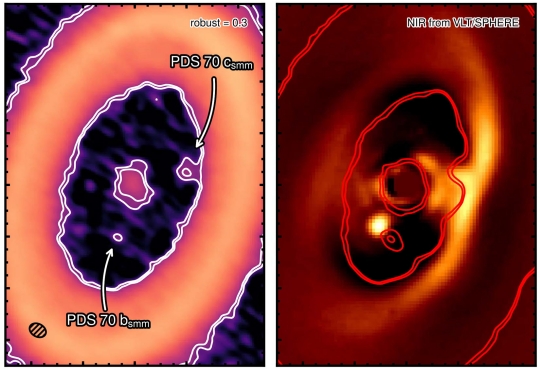
Image: Radio astronomers using the Atacama Large Millimeter/submillimeter Array of telescopes in Chile have found a disk of gas and dust (left) around exoplanet PDS 70 c, a still-forming gas giant that was obscured from view in the 2018 infrared image (right) that first revealed its sister planet, PDS 70 b. Credit: A. Isella, ALMA (ESO/NAOJ/NRAO).
I want to clear this up because several emails express confusion about which planet is doing what. What’s happening is that two separate teams are reporting on findings that deepen our interest in this young system. Circumplanetary disks are new terrain for exoplanetology, and most models of planet formation show that such disks last no more than 10 million years. Thus observing what may be two instances of moons forming around planets in the same system is an extraordinary opportunity. No wonder multiple teams are digging into it.
On the PDS 70b possibility, Isella reports the detection of a continuum emission “close, but not coincident, to the position of PDS 70 b.” His team has two sources of emission that are interesting, one near each forming world, and labels them PDS 70 csmm and PDS 70 bsmm respectively, the ‘smm’ standing for ‘submillimeter.’
In Isella’s work, the millimeter wavelength observations of this star from ALMA were backed by data from the VLT’s SPHERE instrument, and a second VLT instrument called MUSE, which observed in the visible wavelength called H-alpha, an emission that occurs when infalling hydrogen is ionized. “It’s complementary to the optical data,” said Isella, “and provides completely independent confirmation that there is something there,”
What Isella is arguing is that the two sources, one near each planet, might have different physical origins, with the source at PDS 70b offset from the planet itself. Here’s what the Isella paper, which appears in Astrophysical Journal Letters, says about PDS 70b:
The last item of discussion concerns the nature of PDS 70 bsmm. Its proximity to PDS 70 b suggests that the observed continuum emission might be somehow related to the planet. Due to the uncertainties on the position of the host star in the ALMA images, we cannot exclude that the sub-millimeter continuum arises for circumplanetary dust.
And here is a color-enhanced image of millimeter-wave radio signals showing the disk of gas and dust around PDS 70c:
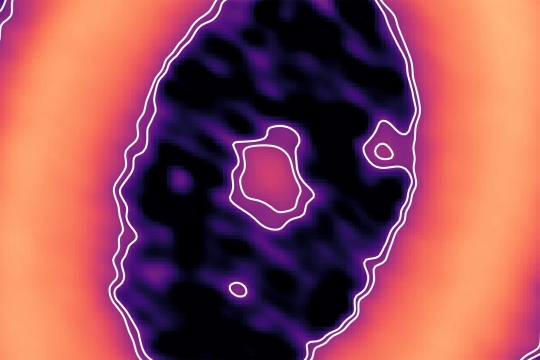
Image credit: A. Isella, ALMA (ESO/NAOJ/NRAO).
Between the two papers, then, we’re looking at the possibility of two circumplanetary disks forming around separate worlds in this system. Both these planets appear to be 5 to 10 times larger than Jupiter, with the innermost at roughly the distance from Uranus to the Sun, while PDS 70c is in an orbit analogous to Neptune’s. It’s clear that this system is going to repay further study, for we are now at the point where our observatories can examine planetary systems in rich detail and observe moon formation in its nascent stages. Says Isella:
“There are a handful of candidate planets that have been detected in disks, but this is a very new field, and they are all still debated. (PDS 70 b and PDS 70 c) are among the most robust because there have been independent observations with different instruments and techniques.”
The Isella paper is “Detection of continuum submillimeter emission associated with candidate protoplanets,” Astrophysical Journal Letters Vol. 879, No. 2 (abstract / preprint). The Christiaens paper is “Evidence for a Circumplanetary Disk around Protoplanet PDS 70 b,” Astrophysical Journal Letters Vol. 877, No. 2 (3 June 2019). Abstract / Preprint.

Extending the Astrobiological ‘Red Edge’
A useful exercise for learning how to look for life elsewhere is to try to find it right here on Earth. Thus Carl Sagan’s observations of our planet via data taken during the 1993 flyby of the Galileo spacecraft, which was doing a gravity assist maneuver enroute to Jupiter. Sagan and team found pigments on the Earth’s surface with a sharply defined edge in the red part of the spectrum. What he was looking at was the reflection of light off vegetation. The ‘red edge’ has become well known in astrobiology circles and is considered a potential biosignature.
On Earth, vegetation is the most abundant reflecting surface indicating life (vegetation covers about 60% of present-day Earth’s land surface). The increase in reflectance shows up at about 700 nm, varying in strength depending upon the species of plant. But as Jack O’Malley-James and Lisa Kaltenegger (Cornell University/Carl Sagan Institute) point out, photosynthetic structures containing chlorophyll are found not just in vegetation but also in lichens, corals, algae and cyanobacteria.
This is helpful, because for anyone looking at the early Earth, the vegetation red edge would have been apparent only after the advent of land plants, while if we can detect a similar feature in other forms of photosynthetic life (call this a photosynthetic red edge, or PRE), we can extend the ability to detect such life back as far as 2 billion years and more (in the case of cyanobacteria). According to the scientists, lichen probably emerged at about the same time as algae, 1 billion years ago, while corals and modern vegetation begin to appear no earlier than 725 million years back.
This offers a much wider ‘window’ in which to observe red edge features on other worlds. The authors’ new paper in Astrophysical Journal Letters looks at what could produce a PRE spectrum aside from land vegetation and asks whether features like these would be detectable. Says Kaltenegger:
“If an alien had used color to observe if our Earth had life, that alien would see very different colors throughout our planet’s history – going back billions of years – when different life forms dominated Earth’s surface. Astronomers had concentrated only on vegetation before, but with a better color palette, researchers can now look beyond a half-billion years and up to 2.5 billion years back on Earth’s history to match like periods on exoplanets.”
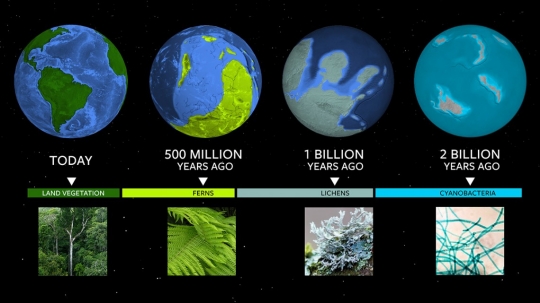
Image: To understand where exoplanets are in their own evolution, astronomers can use Earth’s biological milestones as a Rosetta stone. Credit: Wendy Kenigsberg/Cornell Brand Communications.
The paper models how a planet’s spectrum would change depending upon the dominant organism on the surface. O’Malley-James refers to the authors’ use of the early Earth in this analysis as a kind of Rosetta Stone, one that extends back halfway as far as the Earth itself. Examining the spectra of Earth-like planets modeled with four different organisms — cyanobacteria, algae, and lichen, as well as deciduous vegetation (lichen, for example, would have cast a sage to mint green color, a distinctive red-edge signature of photosynthesis), the authors show that the addition of an atmosphere and clouds to the model can mask individual features but still produce enough data to reach a broader conclusion: From the paper:
…for similar surface coverage the PRE signal of other organisms that could be dominant on the surface of an exoplanet can be similar in strength to the signal produced by modern vegetation for Earth in our models, which is approximated using deciduous tree reflectance producing an estimated reflectance increase of ?4% (Table 1), falling within the lower end of the range of values (1%–10%) given for Earth’s VRE,,, Figure 1 shows that individually the different organisms can be distinguished with high spectral resolution. However, once we add a present-day Earth atmosphere as well as clouds to the model…, the individually distinguishing slope of the reflectivity of the organisms is no longer apparent. Thus a red edge detection, while not being specific to any one form of photosynthetic organism, can indicate a wider range of organisms than only vegetation.
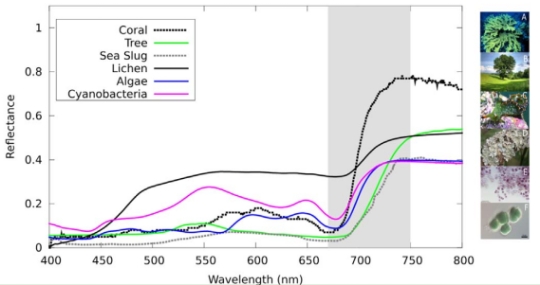
Image: This is Figure 1 from the paper. Caption: Examples of red edge features—the increase in reflectance caused by chlorophyll, highlighted in the shaded region—exhibited by (A) corals, (B) deciduous vegetation (trees; representative of the present-day red edge feature in Earth’s spectrum), (C) the photosynthetic sea slug, Elysia viridis, (D) lichen (Acarospora sp.), (E) algae (Rhodosorus marinus), (F) cyanobacteria (Chroococcidiopsis sp.). Credit: Jack O’Malley-James/Lisa Kaltenegger.
The red edge would be a difficult biosignature detection but not beyond the reach of high-precision instruments as we move to the next generation of observatories. It also provides another tool for biodetection that in combination with atmosphere analysis offers a multi-pronged approach to our remote probing for life, lessening the potential ambiguity of the results.
The paper is O’Malley-James & Kaltenegger, “Expanding the Timeline for Earth’s Photosynthetic Red Edge Biosignature,” Astrophysical Journal Letters Vol. 879, No. 2 (10 July 2019). Abstract.

A Gravitational Wave Approach to Exoplanets
We should always be on the lookout for new ways of finding exoplanets. Right now we’re limited by our methods to stars within the neighborhood of the Sun (in galactic terms), for both radial velocity and transit detections are possible only around brighter, closer stars. The exception here is gravitational microlensing, capable of probing deep into the galaxy, but here the problem is one of numbers. We simply don’t make enough detections this way to build up the kind of statistical sample that the Kepler mission has provided in terms of transiting planets.
So how significant is this kind of selection bias, which thus far has been forced upon us? Without knowing the answer, we would do well to explore ideas like those put forward by Nicola Tamanini (AEI Potsdam) and colleague Camilla Danielski (CEA/Saclay, Paris). The two scientists are looking at the possibilities of gravitational wave astronomy, looking toward the launch, in the 2030s, of LISA, the Laser Interferometer Space Antenna.

Image: Artistic representation of gravitational waves produced by a compact binary white dwarf system with a jovian mass planetary companion. Credit: © Simonluca Definis.
This is rarified air indeed, and the kind of target in play is likewise a rarity, giant exoplanets orbiting detached double white dwarf binaries (DWDs). These are intriguing objects, eclipsing double white dwarfs, remnants of stars like our Sun that have passed beyond their red giant phase. Short-period DWDs with orbital periods less than one hour are rarer still. But they’re worth seeking out because these short-period binaries generate powerful gravitational waves.
What the authors propose in their new paper in Nature Astronomy is to use gravitational waves to find circumbinary planets, worlds that orbit both stars in the binary. We have no planets around white dwarf binaries in our catalog at present, but LISA should be able to remedy that by identifying DWDs both inside and outside the Milky Way. Perturbations in the gravitational wave signal would then flag the presence of a third gravitationally bound object, a giant planet. Thousands of DWDs are expected to be found, producing no shortage of targets.
Tamanini likens the method to Doppler modulations of the kind we use with radial velocity studies, this being their gravitational wave analog. But significantly, gravitational waves are not affected by the kind of stellar activity that can confound radial velocity signals. Nor are we hampered by distance to the degree we are when using electromagnetic means, for gravitational wave perturbations should be apparent from anywhere in the galaxy and nearby galaxies as well. The scientist believes LISA could detect exoplanets down to about 50 Earth masses throughout this range.
If Tamanini’s conclusions are valid, the method would therefore bring the kind of large statistical sample we derived from Kepler to the domain of post-main sequence stellar systems, which means we are pushing into regions in what he calls the ‘planetary Hertzsprung-Russell diagram’ that have not yet been explored. Valid over the entire galaxy, the data would be free of selection effect. Moreover, the paper points out that follow-up observations of close-in DWDs will be helpful in confirming the LISA identification and deepening our knowledge of its characteristics:
Imaging of CBPs [circumbinary planets] around DWDs can be used to test the presence of a second generation of exoplanets in the outer regions of a planetary system, and consequently to provide constraints on migration theories. Emission spectra of these objects will furthermore allow us to estimate their temperature and the main molecular component of their atmosphere, making direct connections to chemical element distributions in the atmosphere of white dwarfs. This would also allow to better understand the observed white dwarf pollution effect. On the other hand, if an existing CBP accretes mass after a common-envelope stage, it becomes brighter, further decreasing the already low planet-to-white dwarfs contrast, meaning that also first-generation, more mature exoplanets can be imaged.
So we are looking at a kind of exoplanet about which we know nothing, if it indeed exists, but bear in mind that about half ot the stellar population occurs in multiple star systems. LISA is expected to measure gravitational waves from thousands of DWDs. Exoplanets here would yield insights into the kind of planet that survives a star’s red giant phase, while probing the regime of any second generation planets — those that form after the red giant phase is complete. We further our knowledge even if LISA finds no exoplanets around DWDs, for then we’ve set statistical constraints on the last phase of planetary evolution.
The paper is Tamanini et al., “The gravitational-wave detection of exoplanets orbiting white dwarf binaries using LISA,” Nature Astronomy 8 July 2019 (abstract).

Keeping Voyager Alive
One of the many legacies of the Voyager spacecraft is the Interstellar Mapping and Acceleration Probe (IMAP). Scheduled for a 2024 launch, IMAP has as part of its charter the investigation of the solar wind’s interactions with the heliosphere, drawing on data from an area into which only the Voyagers have thus far ventured. Let me hasten to add that IMAP will stay much closer to home, orbiting the Sun-Earth L1 Lagrange point, but like the Interstellar Boundary Explorer (IBEX), it will help us learn more about a region physically reachable only by long-duration craft.
The fact that we’re still talking about Voyager as an ongoing mission is the story here. Launched in 1977, the doughty probes have kept surprising us ever since. In terms of their longevity, I noted in 2017 that when Voyager 1’s thrusters had begun to lose their potency (they’re needed to keep the spacecraft’s antenna pointed at Earth to return data), controllers were able to fire a set of backup thrusters that hadn’t been used for a whopping 37 years.
Even the Voyager Interstellar Mission, an extension to the primary, is long in the tooth, having begun when the two spacecraft had been in flight no more than twelve years. These days Voyager is all about power management, for we’re still getting good data. Voyager 1’s cosmic ray instrument is still at work, along with a plasma instrument, its magnetometer, and its low-energy charged particle instrument. Voyager 2 likewise studies cosmic rays, operates two plasma instruments, a magnetometer, and its own low-energy charged particle instrument.
Voyager instruments are proving to be as tenacious as bulldogs. Consider: Voyager 2’s cosmic ray subsystem (CRS) continues to run although engineers have turned off the heater that keeps it warm to save power, as part of a new power management plan for both spacecraft. The CRS now functions at -59 degrees Celsius, a good 15 degrees colder than it was originally tested for back in the days before launch. Voyager 1’s ultraviolet spectrometer continued to function for years after losing its heater as part of an earlier power strategy implemented in 2012.
Voyager project manager Suzanne Dodd (Jet Propulsion Laboratory) notes how important it is to make choices about power and instruments, given that the heat available from the three radioisotope thermoelectric generators (RTGs) aboard each craft decreases with time, for each spacecraft produces 4 fewer watts of electrical power each year. We’re down to 60 percent of the heat energy the RTGs could produce at launch, so hard decisions have to be made about which systems to keep operational. Says Dodd:
“It’s incredible that Voyagers’ instruments have proved so hardy. We’re proud they’ve withstood the test of time. The long lifetimes of the spacecraft mean we’re dealing with scenarios we never thought we’d encounter. We will continue to explore every option we have in order to keep the Voyagers doing the best science possible.”
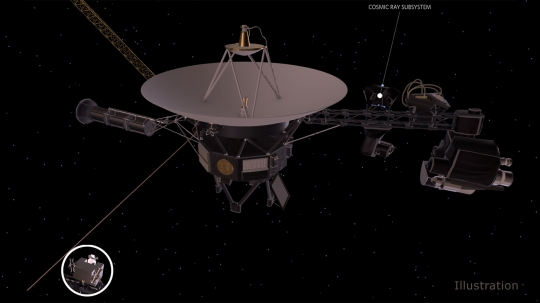
Image: This artist’s concept depicts one of NASA’s Voyager spacecraft, including the location of the cosmic ray subsystem (CRS) instrument. Both Voyagers launched with operating CRS instruments. Credit: NASA/JPL-Caltech.
The cosmic ray subsystem had its heater turned off despite its role in detecting Voyager 2’s passage through and exit from the heliosphere, the ‘bubble’ produced by the outflow of solar wind particles from the Sun. One aspect of this difficult choice is that the CRS can only look in specific fixed directions, making its heater in this environment expendable. Voyager 2 is driving the new power plan because it has one more instrument collecting data than Voyager 1.
If there is one place where power remains essential to the last, it’s the fuel lines that power the Voyager thrusters. In addition, Voyager 2’s current thrusters are degrading, just as Voyager 1’s did, forcing a switch to trajectory correction maneuver (TCM) thrusters last used during the encounter with Neptune in 1989. That switch should take place later this month. Let’s give a nod to Aerojet Rocketdyne, whose MR-103 thrusters have performed beyond all expectation, as has the mission itself, originally slated to last but five years.
One day, probably in the coming decade though perhaps late in it, the amount of electrical power needed to keep both spacecraft operational will no longer be available. Here’s hoping we get at least eight more years out of the Voyagers so that they’re still with us on their 50th anniversary. My own hunch is that the gifted people managing the Voyager Interstellar Mission may just find enough tricks to get them through to 2030 before the flow of data ceases.
As I’m still delighted to say, this mission isn’t over. Go Voyager.

